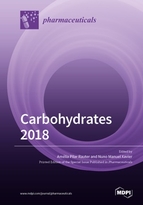Carbohydrates 2018
A special issue of Pharmaceuticals (ISSN 1424-8247).
Deadline for manuscript submissions: closed (15 June 2019) | Viewed by 51056
Special Issue Editors
Interests: carbohydrate small molecule synthesis; organic and biomolecular chemistry developments towards new therapeutic approaches for diabetes; Alzheimer’s disease and other amyloid diseases and carbohydrate-based antibiotics
Special Issues, Collections and Topics in MDPI journals
Interests: organic chemistry; medicinal chemistry; carbohydrate and nucleos(t)ide chemistry; bioactive molecules; enzyme inhibitors; anticancer agents; antimicrobial agents; anti-Alzheimer’s agents
Special Issues, Collections and Topics in MDPI journals
Special Issue Information
Dear Colleagues,
Carbohydrates play a major role in a diversity of processes, which are encompassed in the areas of chemistry, biochemistry, biology and medicinal chemistry. Among the topics covered at the 29th International Carbohydrate Symposium (ICS2018), special attention is given to recent advances and emerging trends in carbohydrate research towards medical applications, including carbohydrates in therapeutics and diagnosis, glycosylation and disease, carbohydrates in inflammation and disease, glycosciences and personalized medicine and carbohydrate vaccines. The growing knowledge on the importance of carbohydrates in health and in disease progress, driving new therapeutic strategies, is the motto for this Special Issue. Contributions arising from the presentations at the Symposium within the context of the previously mentioned topics are welcome.
Speakers at the symposium are cordially invited to submit original research manuscripts to this Special Issue of Pharmaceuticals.
Prof. Dr. Amélia Pilar Rauter
Dr. Nuno Manuel Xavier
Guest Editors
Manuscript Submission Information
Manuscripts should be submitted online at www.mdpi.com by registering and logging in to this website. Once you are registered, click here to go to the submission form. Manuscripts can be submitted until the deadline. All submissions that pass pre-check are peer-reviewed. Accepted papers will be published continuously in the journal (as soon as accepted) and will be listed together on the special issue website. Research articles, review articles as well as short communications are invited. For planned papers, a title and short abstract (about 100 words) can be sent to the Editorial Office for announcement on this website.
Submitted manuscripts should not have been published previously, nor be under consideration for publication elsewhere (except conference proceedings papers). All manuscripts are thoroughly refereed through a single-blind peer-review process. A guide for authors and other relevant information for submission of manuscripts is available on the Instructions for Authors page. Pharmaceuticals is an international peer-reviewed open access monthly journal published by MDPI.
Please visit the Instructions for Authors page before submitting a manuscript. The Article Processing Charge (APC) for publication in this open access journal is 2900 CHF (Swiss Francs). Submitted papers should be well formatted and use good English. Authors may use MDPI's English editing service prior to publication or during author revisions.
Keywords
- glycosylation-related diseases/disorders
- disease-associated carbohydrate-processing enzymes
- carbohydrate-based therapeutics
- carbohydrate-based lead molecules
- medicinal glycochemistry
Related Special Issue
- Glycomimetics and Glycoconjugates in Drug Discovery in Pharmaceuticals (8 articles)








